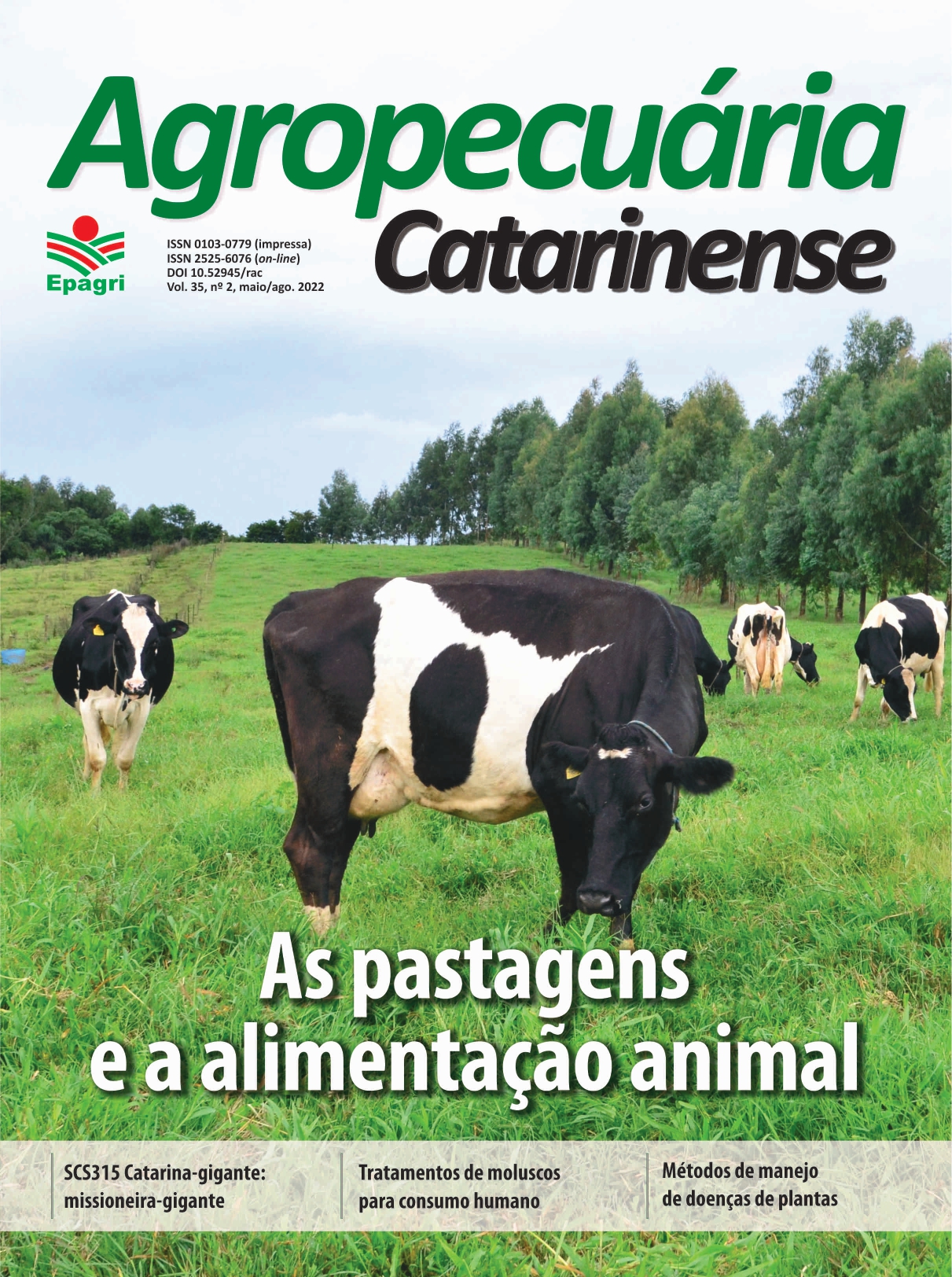Requerimentos agroclimáticos para a cultura do lúpulo
DOI:
https://doi.org/10.52945/rac.v35i2.1273Palavras-chave:
Humulus lupulus L, fotoperíodo, temperatura, soma térmica, dormência, vernalizaçãoResumo
O lúpulo é uma nova espécie com interesse de cultivo em Santa Catarina. Poucas são as informações locais a respeito da sua adaptação e de seu desempenho nas condições climáticas do Estado. Apesar de ser uma planta originária de clima
temperado e altas latitudes, com invernos frios e fotoperíodo variável ao longo do ano, experiências de cultivo demonstram viabilidade em regiões mais quentes e de latitudes mais baixas. Este fato demonstra que alguns parâmetros agroclimáticos, até agora considerados adequados ao crescimento e desenvolvimento da cultura, são controversos. Este estudo objetiva discutir estes parâmetros à luz dos conhecimentos atualmente existentes.
Métricas
Referências
BAUERLE, W.L. Disentangling photoperiod from hop vernalization and dormancy for global production and speed breeding. Sci Rep. v.9, 16003, 2019. https://doi.org/10.1038/s41598-019-52548-0
BURGESS, A.H., Hops, botany, cultivation and utilization. ed. Polunin, N.
Interscience Publishers, New York ,1964.
CARRILHO, F. Necessidades do lúpulo do ponto de vista do clima e trabalhos
culturais. 1as Jornas Técnicas sobre a Cultura do Lúpulo, Braga. 1981.
CRAIN, M.N. Factors controlling hop flowering and their potential and their potential for use in the brewing and pharmaceutical industries. Honors Program Theses. 33p., 2011. https://scholarworks.uni.edu/hpt/10
DE CARVALHO, V.P. Zoneamento agroclimático da cultura de lúpulo para o estado do rio de janeiro: uma aplicação da lógica fuzzy. Dissertação (mestrado). UFRJ, 115p., 2018.
ERIKSEN, R.L.; RUTTO, L.K.; DOMBROWSKI, J.E.; HENNING, J.A. Photosynthetic Activity of Six Hop (Humulus lupulus L.) Cultivars under Different Temperature Treatments. HORTSCIENCE, v.55, n.4, p. 403-409, 2020.
DODDS, K. Hops, a guide for new growers. NSW Department of Primary Industries, 44 p., 2017.
FAGHERAZZI, M. M. Adaptabilidade de cultivares de lúpulo na região do planalto sul catarinense. Tese (Dourorado), UDESC, 118p., 2020.
HILTON, J.F. Farm Fresh Hops for six generation, 2002. Disponivel em:
Kralj D. Influence of temperature and rainfall on the growth of Savinja Golding. Proceedings of I Yugoslavian symposium of hop production, Velenje, Slovenia ; p. 7-20. 1962.
MAROVT, M.. Vpliv gostote in razporeditve rastlin na rast, razvoj in kakovost
hmelja (Humulus Lupulus L.) kultivarja 279D112. 2007. 51 p.. TCC (Graduação) -
Curso de Agronomijo, Univerza V Ljubljani, Ljubljana, 2007.
PAVLOVIČ, V., PAVLOVIČ, M.,ČERENAK, A., KOŠIR, I. J., ČEH, B., ROZMAN, TURK,
J., PAZEK, K., KROFTA, K., GREGORIC, G., Environment and weather influence on quality and Market value of hops, Plant Soil Environment, v. 58, p. 155-160, 2012.
RYBACEK, V. Hop Production, vol. 16. 1st edition. Holland: Elsevier Science. 286 p., 1991.
SPÓSITO, M.B. et al.. A cultura do lúpulo / -- Piracicaba: ESALQ Divisão de Biblioteca, 81 p., 2019 (Série Produtor Rural, no. 68).
SIRRINE, J.R. Sustainable Hoop Production in the Great Lakes Region. MSU Extention, 2009.
THOMAS, G.G., SCHWABE, W.W. Factors Controlling Flowering in the Hop (Humulus lupulus L.). Ann. Bot.v.33, p.781-793, 1969.
WAGNER T. Hmeljarstvo. 1. del – skripta. Kmetijski kombinat Žalec: 115 str.1968.
WAGNER T. Vpliv temperature in vlage na pridelek hmelja v Sloveniji. Hmeljarski
bilten, v.3, p. 81-88, 1975.
WILLIAMS, I.H.; ROBERTS, J.B.; COLEY‑SMITH, J.R. Studies of the dormant phase of the hop (Humulus lupulus L.) Annual report for 1960. Department of Hop Research, Wye College England, p. 48–58. 1961.
ZMRZLAK, M. Dynamics of phenological development of hops (cv. Savinjski Golding, Aurora) related to air temperature in lower Savinja valley. Graduation Thesis. Univerza v Ljubljani, Biotehniška fakulteta, Agronomija: p. 11-59. 1991.
ZMRZLAK M., KAJFEŽ-BOGATAJ L. Phenological modeling of growth stages of the hop (Humulus lupulus L.). Biometeorology, Proc. of the 14th Int. Con. of Biometeorology, Ljubljana, Slovenia, 1996.
Downloads
Publicado
Como Citar
Edição
Seção
Licença
Copyright (c) 2022 Gabriel Berenhauser Leite, Cristina Pandolfo

Este trabalho está licenciado sob uma licença Creative Commons Attribution 4.0 International License.




